7 Telemedicine Trends That Build the Future of Telemedicine
Modern technologies nowadays are tightly connected with the healthcare industry (and telemedicine trends, accordingly). In this dance of healthcare and technology, telemedicine takes center stage, leading us toward a future where connections are deeper, care is more efficient, and patients are truly at the heart of it all. In simple words, telemedicine is the remote delivery of healthcare services and medical consultations through the use of digital communication technologies. The evolution of telemedicine is not just a timeline; it is a story of change, innovation, and the constant desire to make healthcare accessible to everyone. The future of telemedicine is quite promising. It consists of many telemedicine trends and is growing extremely fast.
In short, here are the key insights we explore in today's article:
- The history of telemedicine dates back to the 50s.
- Does telehealth relate to telemedicine? Not really, although they both relate to healthcare. Telemedicine is all about clinical services delivered online, while telehealth is typically associated with non-clinical services like patient education.
- Did COVID influence the future of telemedicine? Absolutely, it empowered the rapid evolution of telemedicine advancements.
- How about the current state of telemedicine? The global telemedicine market is expected to reach $ 63852.92 million in 2028 (CAGR - 10.65).
- What are the top telemidicine trends? Hybrid care models, AI integration, telesurgery, telepsychiatry, teleophthalmology, wearables, remote patient monitoring, mental health services, online counseling platforms, etc.
More and more enterprises worldwide are implementing such healthcare technologies as Telemedicine & Telehealth Platforms, Electronic Prescription Software Solutions, Pharmacy Payment & Management System, Data Management Healthcare Solutions, Healthcare API & Integration, Medical Device Integration, Mobile Healthcare Solutions, etc. We will definitely describe all these technologies in today's article.
But if you are interested in implementing some of these technologies right now, you can always contact devabit. Our custom healthcare development company has a team of experts with extensive experience in the healthcare domain. With many successful projects behind, devabit provides customized healthcare solutions designed to meet the unique needs of each healthcare organization. Whether it is a telemedicine platform, a data management solution, or an electronic prescription system, our skilled team always tries to understand clients' unique requirements so we can deliver solutions perfectly tailored to their needs.
And now, let us dive into the complicated world of healthcare and tell you more about the past and future of telemedicine, its main features and peculiarities, and, of course, the main telemedicine trends.
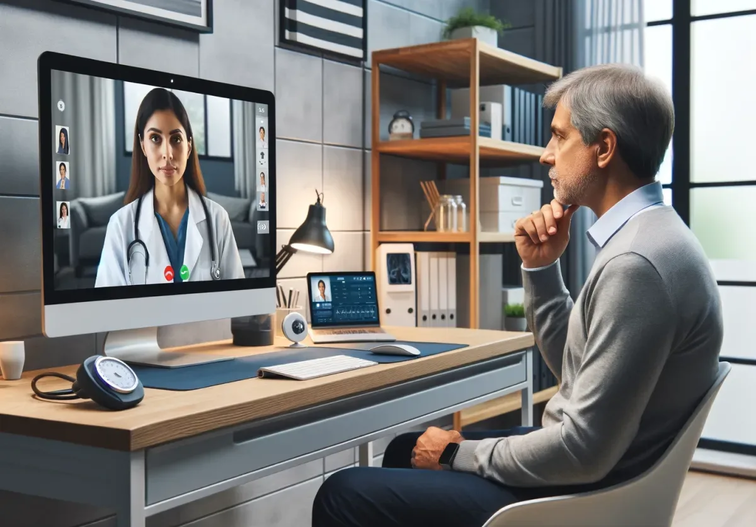
- The Future of Telemedicine: How Everything Began
- The Future of Telemedicine after COVID-19
- The Future of Telemedicine: Current Landscape
- The Main Telemedicine Trends: Hybrid Care Models
- The Main Telemedicine Trends: AI Integration
- The Main Telemedicine Trends: Expended Specialized Services
- The Main Telemedicine Trends: Wearable Technology and Remote Monitoring
- The Main Telemedicine Trends: Policy Evolution
- The Main Telemedicine Trends: Mental Health Services
- The Main Telemedicine Trends: Globalization
- Conclusion: Prognosing the Future of Telemedicine
The Future of Telemedicine: How Everything Began
In the recent past, even the concept of receiving medical care without a physical visit to the hospital might have seemed like science fiction. With the growth of telemedicine, this futuristic notion has turned into a present-day reality that has revolutionized the way healthcare is delivered.
The history of telemedicine begins in the mid-20th century, when advancements in telecommunications and information technology laid the groundwork for remote medical consultations. One of the pioneering moments occurred in the 1950s, when radiologic images were transmitted over telephone lines for diagnostic purposes. This was the real beginning of new technologies that would ultimately redefine the future of telemedicine trends.
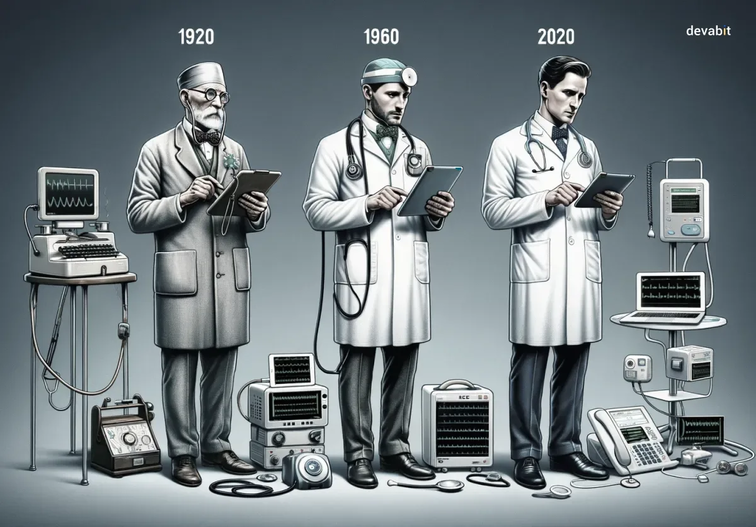
Since the internet has begun to gain more popularity in the late 20th century, many tools that were considered the future of telemedicine have become our reality. Such rapid development enabled healthcare professionals to share information and interact with patients in real-time across vast distances.
As a result, initially used for consultations in remote or underserved areas, telemedicine rapidly gained traction as a practical solution for improving healthcare accessibility. The turn of the 21st century witnessed a huge development of telemedicine trends, driven by technological advancements, improved internet connectivity, and a growing demand for more convenient healthcare options. Innovations such as video conferencing, mobile health applications, and wearable devices played crucial roles in shaping the future of telemedicine.
Telehealth: Part of Telemedicine Trends or Completely Another Industry?
Together with the development of telemedicine trends that we will describe in the next paragraphs, the telehealth industry has been gaining more popularity. To compare these two technologies, telehealth is a broader term that covers various health services delivered remotely.
In simple words, if the future of telemedicine primarily relies on clinical services delivered online, typically involving virtual visits with healthcare providers, telehealth provides non-clinical services like patient education, training for healthcare professionals, and healthcare-related communication conducted online.

If you are interested in the complex comparison of telehealth & telemedicine, you should definitely read our last article. We are sure you will really admire it.
The Future of Telemedicine After COVID-19
The COVID-19 pandemic has obliged many people to stay at home without the ability to visit the doctor. It acted as a catalyst for the widespread integration of telemedicine, forcing telemedicine trends to grow faster and faster. In many ways, the COVID-19 pandemic has demonstrated how powerful and useful the future of telemedicine is. These are several features that were improved during the COVID-19 pandemic.

Increased Accessibility
The pandemic forced both healthcare providers and patients to overcome initial hesitations about remote care. As a result, telemedicine trends have become more widely accepted as a legitimate and convenient mode of healthcare delivery. Patients now appreciate the flexibility and accessibility that telemedicine offers, eliminating the need for time-consuming commutes and reducing barriers to care.
Diverse Applications Across Specialties
The future of telemedicine trends stands for creating medical applications that have expanded across various medical specialties. Mental health services, chronic disease management, dermatology, and even certain surgical consultations are now conducted remotely. These trends in have proven its efficacy in various healthcare scenarios, providing high-quality solutions for different medical needs.
Technological Advancements
Many medical institutions have already implemented telehealth & telemedicine trends. Improved video conferencing platforms, enhanced security measures for patient data protection, and the integration of artificial intelligence for diagnostics and triage are just a few examples of how technology has evolved to meet the demands of telehealth.
As technology continues to progress, telemedicine is likely to incorporate even more innovative solutions, further enhancing the quality of care delivered remotely. If you are interested in implementing telemedicine trends and tools in your enterprise, contact the devabit team. We have already assisted many companies to grow and popularize remote patient care.
Global Reach and Healthcare Disparities
The future of telemedicine has the potential to address healthcare disparities by reaching underserved and remote populations. The global reach of telehealth trends has the capacity to connect patients with specialized medical expertise, irrespective of geographical constraints. This has the potential to bridge gaps in healthcare access and improve health outcomes on a global scale.
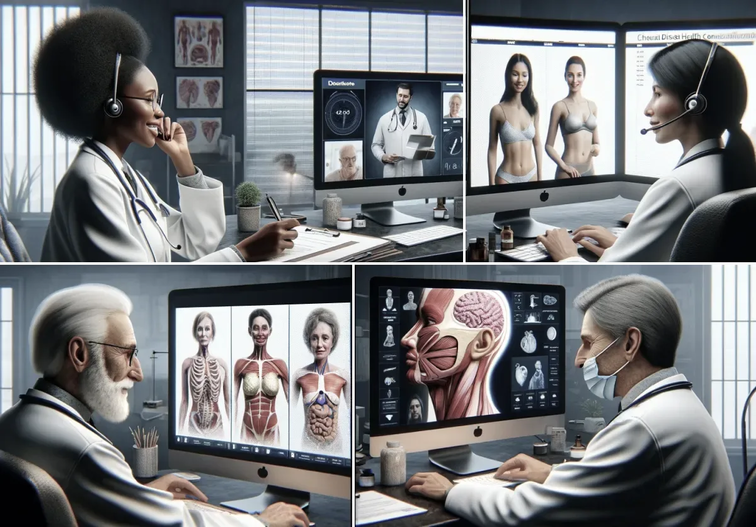
In conclusion, the post-COVID landscape has made telemedicine a crucial component of modern healthcare delivery. As telemedicine continues to evolve, more and more medical institutions will implement the latest telemedicine trends and popularize remote patient care.
The Future of Telemedicine: Current Landscape
The future of of telemedicine is characterized by the dynamic development of new telemedicine trends that will be the basis of the future of telemedicine, building a collaborative healthcare ecosystem. Advanced technologies, including artificial intelligence and virtual reality, are integral to telemedicine's capabilities, transforming diagnostics, treatment planning, and personalized medicine.
Digital health platforms offer comprehensive services, from video consultations to seamless integration with electronic health records, improving the patient experience. Remote patient monitoring has gained much popularity, enabling continuous tracking of vital signs and chronic conditions, contributing to proactive intervention and improved outcomes.
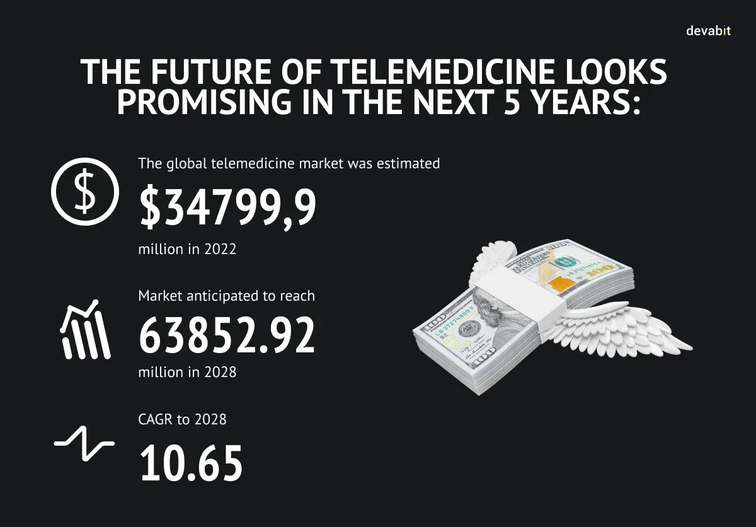
According to LinkedIn’s latest research, the future of telemedicine looks promising in the next 5 years. As of 2022, the global telemedicine market was estimated at USD 34799.9 million, and it’s anticipated to reach USD 63852.92 million in 2028, with a CAGR of 10.65.
The Global Telemedicine market is anticipated to rise at a considerable rate during the forecast period, between 2023 and 2031. In 2026, the market is growing at a steady rate, and with the rising adoption of strategies by key players, the market is expected to rise over the projected horizon.
Overall, the future of telemedicine will provide lots of new telemedicine trends that we will describe below.
The Main Telemedicine Trends: Hybrid Care Models
The adoption of hybrid care models represents a fundamental way of healthcare delivery, combining traditional in-person visits with the flexibility of telemedicine. These telemedicine trends allow patients to choose the most suitable variant, whether it is a virtual or face-to-face medical interaction.
Hybrid care models offer a comprehensive approach to healthcare, ensuring that patients receive the right level of care at the right time. In these telemedicine trends, routine follow-ups, preventive care, and straightforward consultations can take place virtually, freeing up in-person appointments for more complex medical issues that require physical examination or procedures.

This not only maximizes healthcare resources but also minimizes unnecessary travel and wait times for patients. The integration of telemedicine into hybrid care models has been accelerated by advancements in digital health platforms, allowing healthcare providers to maintain a cohesive patient record across both virtual and in-person interactions.
These telemedicine trends are not only improving the patient experience but also contributing to more efficient and patient-centered healthcare systems. After all, what will happen to telemedicine in the future? As technology continues to develop, the future of telemedicine will be totally connected with modern healthcare delivery, offering a flexible and patient-centric approach to medical services.
The Main Telemedicine Trends: AI Integration
The integration of artificial intelligence into the future of telemedicine is completely changing the way healthcare is delivered and managed. AI-powered applications are utilized for tasks such as diagnostics, risk prediction, and personalized treatment planning, enhancing the accuracy of healthcare services. Machine learning algorithms can analyze vast datasets, identifying patterns and trends that might be challenging for specialists to consider.
This capability is particularly valuable in fields like radiology and pathology, where AI can assist in interpreting medical images with high precision. As an integral part of telemedicine advancements, data analytics play a crucial role in population health management within the telemedicine landscape. By analyzing patient data, healthcare providers can identify trends, manage chronic conditions, and allocate resources effectively.

Such proactive approach makes early intervention possible, contributing to improved patient outcomes. It also provides an opportunity to implement preventive measures at early stages, assisting in saving lives and improving patient care.
Moreover, the integration of AI and data analytics supports telehealth platforms in providing personalized healthcare recommendations based on an individual's health history, lifestyle, and genetic factors. These telemedicine trends provide faster decision-making augmented by intelligent algorithms, leading to more precise diagnostics and tailored treatment plans. The ongoing development of these capabilities holds great potential for shaping the future of telemedicine as a sophisticated approach to healthcare delivery.
The Main Telemedicine Trends: Expanded Specialized Services
The majority of telemedicine trends have a huge impact on various medical disciplines. The future of telemedicine is no longer confined to general consultations; now it relates to specialized fields such as telesurgery, telepsychiatry, and teleophthalmology.
Telesurgery
Advances in robotics and high-speed internet have paved the way for telesurgery, where surgeons can perform procedures remotely. This is particularly impactful in scenarios where a specialist's expertise is needed in real-time, transcending geographical barriers and bringing surgical precision to remote locations.

Telepsychiatry
Mental health services have experienced a significant paradigm shift through telepsychiatry. Virtual therapy sessions, online counseling platforms, and mental health apps are providing accessible and confidential support. This approach reduces the stigma associated with seeking mental health assistance and increases the reach of mental health services to a broader population.
Teleophthalmology
Remote ophthalmic consultations enable patients to receive eye care services from specialists without the need for travel. The use of digital imaging and video conferencing allows for accurate assessments of eye conditions, early detection of diseases, and timely intervention.

All in all, the future of telemedicine 2026 will definitely foster global collaboration between healthcare professionals all over the world. It is breaking down geographical barriers and ensuring that individuals, regardless of their location, can benefit from the expertise of specialized healthcare providers. As telemedicine trends continue to develop, the scope of specialized telehealth services is likely to expand further, redefining the possibilities for remote medical care in various specialized domains.
The Main Telemedicine Trends: Wearable Technology and Remote Monitoring
The integration of wearable technology and remote monitoring into the future of telemedicine is ushering in a new era of personalized healthcare. Wearable devices, such as smartwatches or fitness trackers, are equipped with sensors that can continuously monitor various health metrics, providing real-time data for both patients and healthcare providers.
Wearables enable individuals to track parameters such as heart rate, blood pressure, sleep patterns, physical activity levels, etc. This continuous health monitoring offers a complete view of an individual's well-being and assists in the early detection of potential health issues.
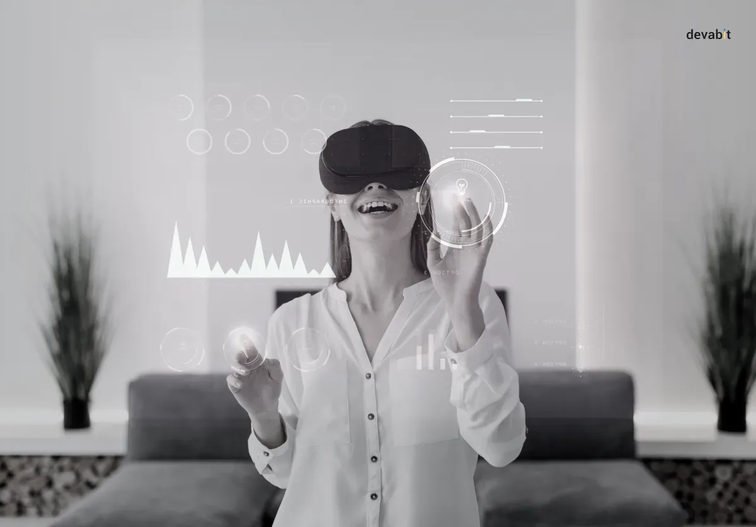
For individuals with chronic conditions, wearable devices play a crucial role in remote monitoring. Patients can share data on vital signs and symptoms with their healthcare providers, reducing the need for frequent in-person visits. These telemedicine trends are increasingly being used for postoperative care, allowing healthcare providers to remotely monitor patients' recovery progress. This not only enhances the efficiency of postoperative care but also provides patients with the convenience of recovering in familiar surroundings.
All in all, these telemedicine trends of wearable technology and remote monitoring align with the broader shift towards patient-centered care. It empowers individuals to actively participate in managing their health, promotes early intervention, and assists in building more personalized treatment plans.
The Main Telemedicine Trends in 2026: Policy Evolution
Nowadays, governments and healthcare regulatory institutions are actively adapting to the growth of telemedicine and telehealth industries, with a focus on ensuring the quality of healthcare services and patient care.
One of the key aspects of policy evolution is the refinement of policies for telehealth services. Governments and insurers are working to establish fair and sustainable reimbursement models that recognize the value of virtual care. This is very important for incentivizing healthcare providers to ensure the financial viability of the future of telemedicine.
For instance, to facilitate the widespread adoption of telemedicine trends, there is a policy towards easing licensure requirements for healthcare providers practicing across state or national borders. Licensure portability enables healthcare professionals to offer their services remotely to patients in different geographical locations, providing specialized care in underserved areas.

Moreover, the establishment of standardized protocols and guidelines for telemedicine trends is gaining prominence. Clear and standardized frameworks help ensure the quality, safety, and consistency of telemedicine services. These protocols cover issues such as patient confidentiality, data security, and appropriate clinical practices in virtual settings.
The ongoing policy evolution is critical to creating an environment conducive to the sustainable growth of telemedicine. As regulatory frameworks become more adaptable, healthcare providers can confidently build telehealth solutions, which leads to increased accessibility, improved patient outcomes, and a more resilient healthcare system.
The Main Telemedicine Trends: Mental Health Services
The evolution in mental healthcare delivery allows telemedicine to provide a range of mental health services remotely. Here are several examples of these telemedicine trends below.
Virtual Therapy Sessions
Telepsychiatry platforms that become possible due to healthcare software solutions provide people with virtual therapy sessions, allowing them to connect with mental health professionals from the comfort of their homes. This approach really reduces barriers such as geographical distance and transportation challenges, making mental health support easily accessible to a broader population.
Online Counseling Platforms
The availability of online counseling platforms and mental health apps allows individuals to access counseling services, mental health resources, and self-help tools anytime, anywhere. These platforms cater to diverse needs, providing support for conditions ranging from anxiety and depression to stress management and general well-being.
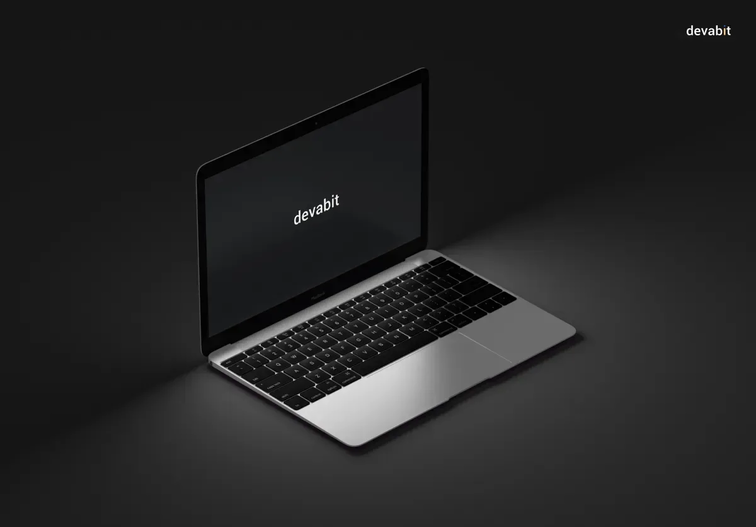
Reducing Stigma
The future of telemedicine in mental health contributes to destigmatizing and seeking psychological support. The convenience and privacy afforded by remote consultations encourage individuals to seek help without the fear of judgment, fostering a more open and accepting approach to mental health care.
These telemedicine trends not only enhance accessibility but also contribute to the broader conversation about mental health, which helps highlight the importance of integrating mental healthcare into mainstream healthcare delivery.
The Main Telemedicine Trends: Globalization
The globalization of the future of telemedicine represents transformative trends that extend the reach of medical expertise and healthcare services across international borders. The future of telemedicine is in improving cross-border medical consultations, enabling patients to seek advice and treatment from healthcare professionals located in different countries. This is particularly beneficial for individuals seeking specialized care or second opinions from experts who may be situated in regions with advanced medical capabilities.

In regions with limited access to healthcare infrastructure, the future of telemedicine serves as a lifeline. It allows patients in remote or underserved areas to connect with medical professionals located elsewhere, overcoming geographical barriers and providing access to a broader spectrum of healthcare services.
Moreover, the future of telemedicine supports collaborative efforts between healthcare institutions, professionals, and organizations worldwide. Through virtual consultations, medical professionals can share knowledge, discuss complex cases, and participate in international medical conferences, contributing to a global exchange of expertise.
During pandemics or emergencies, telemedicine boosts rapid communication, remote monitoring, and coordination of healthcare efforts across borders.
These telemedicine trends not only enhance healthcare access but also contribute to the collective improvement of medical practices and patient outcomes worldwide.
Conclusion: Prognosing the Future of Telemedicine
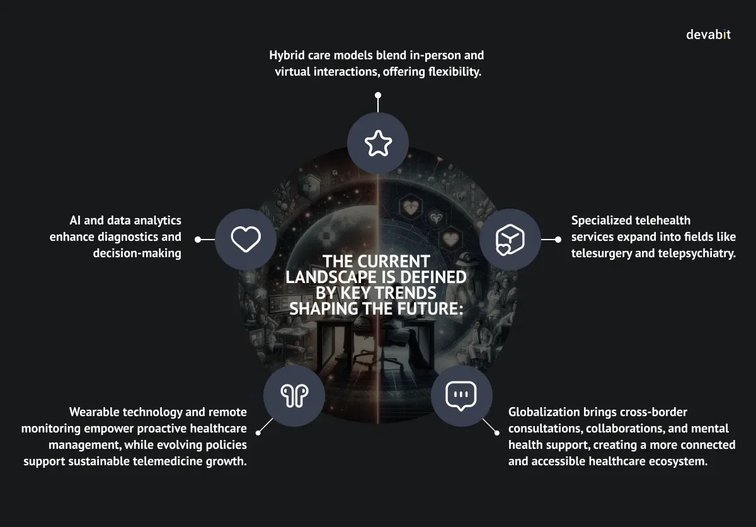
All in all, telemedicine's journey, from its early stages to the present, highlights a revolution in healthcare delivery.
The current landscape is defined by the key trends shaping the future of telemedicine:
- Hybrid care models blend in-person and virtual interactions, offering flexibility.
- AI and data analytics enhance diagnostics and decision-making.
- Specialized telehealth services expand into fields like telesurgery and telepsychiatry.
- Wearable technology and remote monitoring empower proactive healthcare management, while evolving policies support sustainable telemedicine growth.
- Globalization brings cross-border consultations, collaborations, and mental health support, creating a more connected and accessible healthcare ecosystem.
In this dynamic landscape, the fusion of technology, policy evolution, and patient-centric care promises a future where healthcare blows up boundaries.
For sure, if you want to popularize remote patient care, you should definitely implement the latest telemedicine trends in your medical institution.
Do not hesitate to contact the devabit team; we know exactly how to assist you!
Telemedicine's strides signify a commitment to a globally connected, accessible, and resilient healthcare future. As we navigate this horizon, innovation and collaboration continue to shape the next era of healthcare delivery!
Recent Publications
Don't miss out! Click here to stay in touch.
Discover More Healthcare Content

Relevant Articles View all categories
View all categories CONNECT WITH US WE’RE READY
TO TALK OPPORTUNITIES
THANK YOU! WE RECEIVED YOUR MESSAGE.
Sorry
something went wrong



